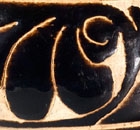J.J. Lally & Co., Oriental Art / New York City, New York
MenuPast Exhibition
The Gordon Collection:
Chinese Ceramics and Works of Art
March 12 - April 4, 2009
47.
A CARVED CIZHOU BROWN-GLAZED POTTERY JAR
Jin Dynasty (A.D. 1115-1234)
of compressed form, with wide mouth and rolled lip, the barrel-rounded sides carved through the rich glossy chocolate-brown glaze to the white slip undercoat with a freely drawn frieze of stylized leaf scroll between double bowstring lines, the tapered lower sides carved with a running band of keyfret also enclosed by double bowstring bands, the interior and the countersunk base also glazed, the wedge-shaped footrim unglazed showing the gray stoneware with a buff surface from the firing.
Diameter 4 1⁄8 inches (10.4 cm)
Exhibited:
Oxford, Iron in the Fire: The Chinese Potters’ Exploration of Iron Oxide Glazes, Ashmolean Museum, 1988
Hare’s Fur, Tortoiseshell, and Partridge Feathers, Chinese Brown- and Black-Glazed Ceramics, 400-1400, travelling exhibition: Cambridge, Harvard University Art Museum; New York, China Institute Gallery; Madison, Elvehjem Museum of Art, University of Wisconsin, 1996-1997
Published:
Ayers, Medley and Wood, Iron in the Fire: The Chinese Potters’ Exploration of Iron Oxide Glazes, Oriental Ceramic Society, London, 1988, no. 31, p. 46
Mowry, Hare’s Fur, Tortoiseshell, and Partridge Feathers, Chinese Brown- and Black-Glazed Ceramics, 400-1400, Cambridge, 1996, no. 67, pp. 188-189
It is rare to find a jar of this type with the additional band of keyfret above the foot. Similar jars with foliate scrolls carved above a plain brown-glazed band are illustrated in Illustrated Catalogues of Tokyo National Museum, Chinese Ceramics: I, Tokyo, 1988, no. 628, p. 156, from the Hirota Collection; by Tregear, Song Ceramics, London, 1982, pl. 99, p. 95, in the Ashmolean Museum, Oxford; by Wirgin, Sung Ceramic Designs, B.M.F.E.A., No. 42, Stockholm, 1970, pl. 55e, from a Swedish Private Collection; and by Krahl, Chinese Ceramics from the Meiyintang Collection, Volume One, London, 1994, no. 453, p. 250, where the author notes that pottery vessels decorated with similar foliate scrolls were made at the Lingwu kilns in Ningxia.
金 磁州黑釉刻花小罐 徑 10.4 厘米
